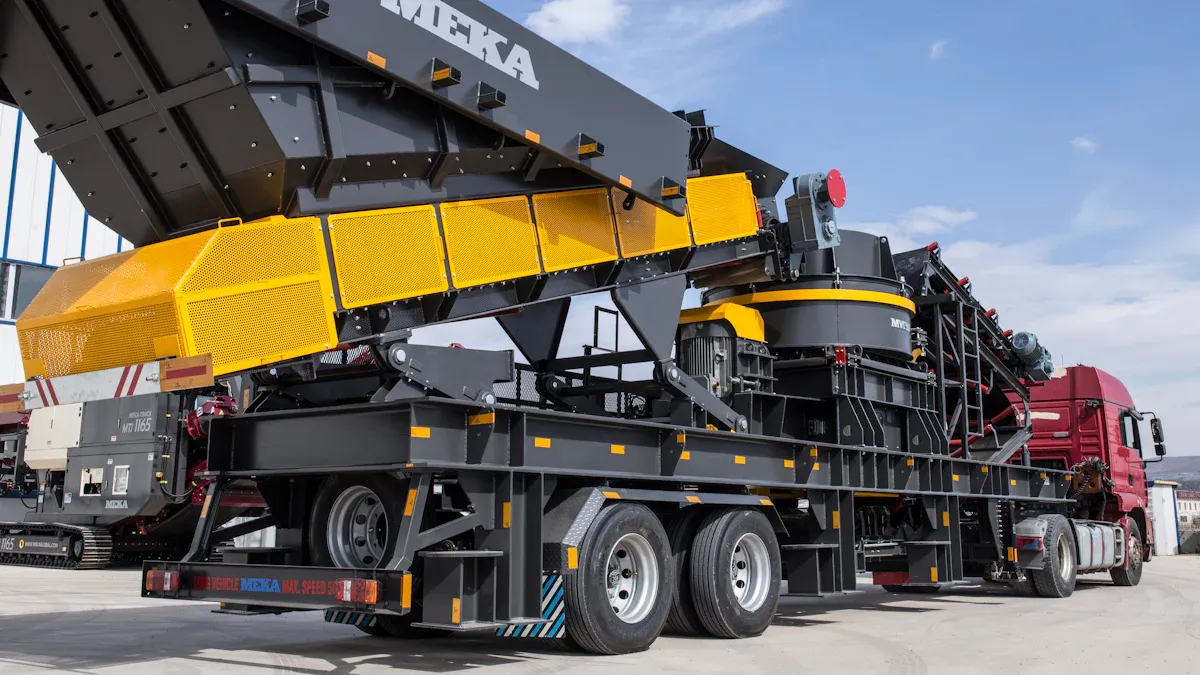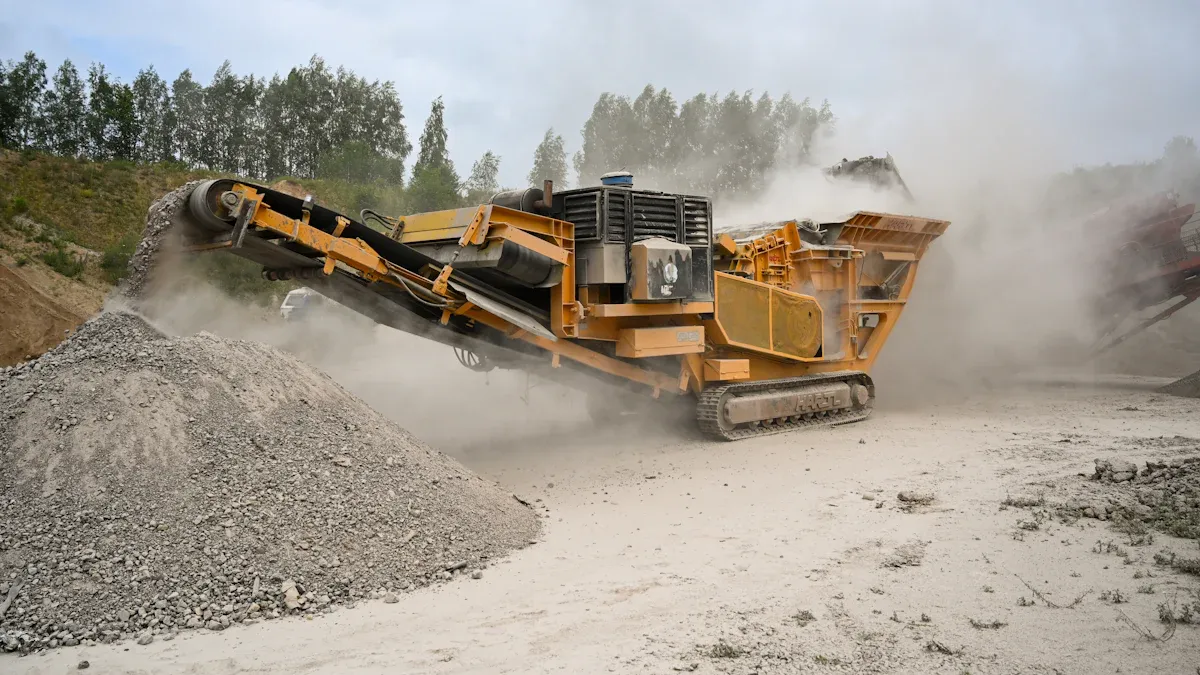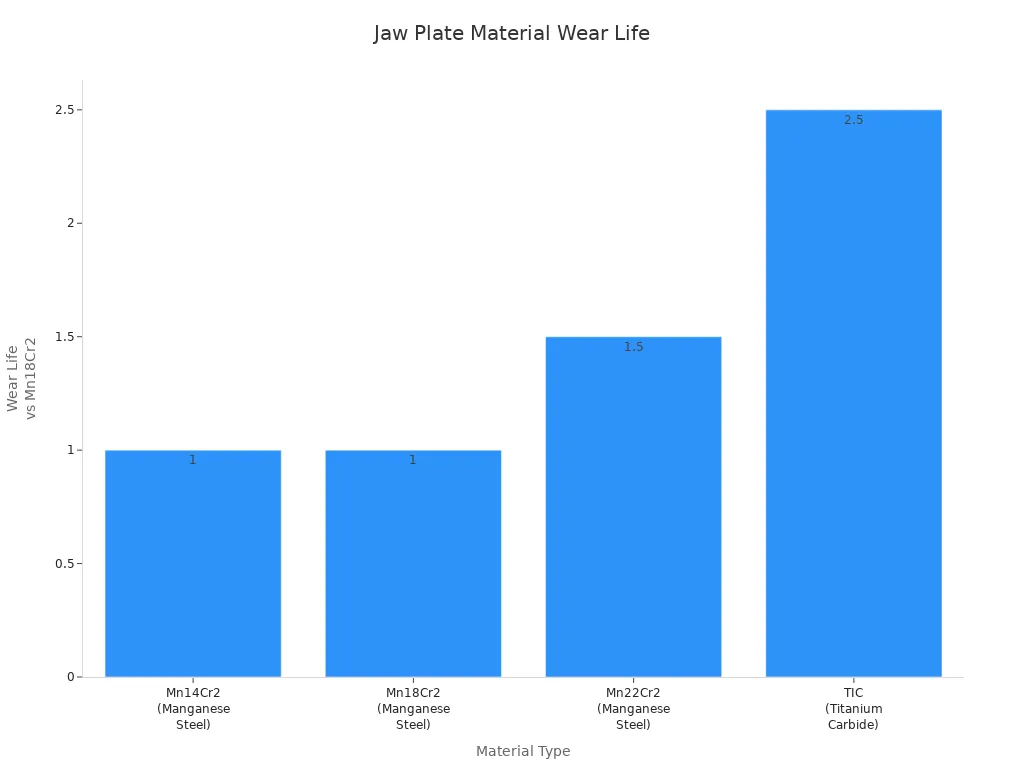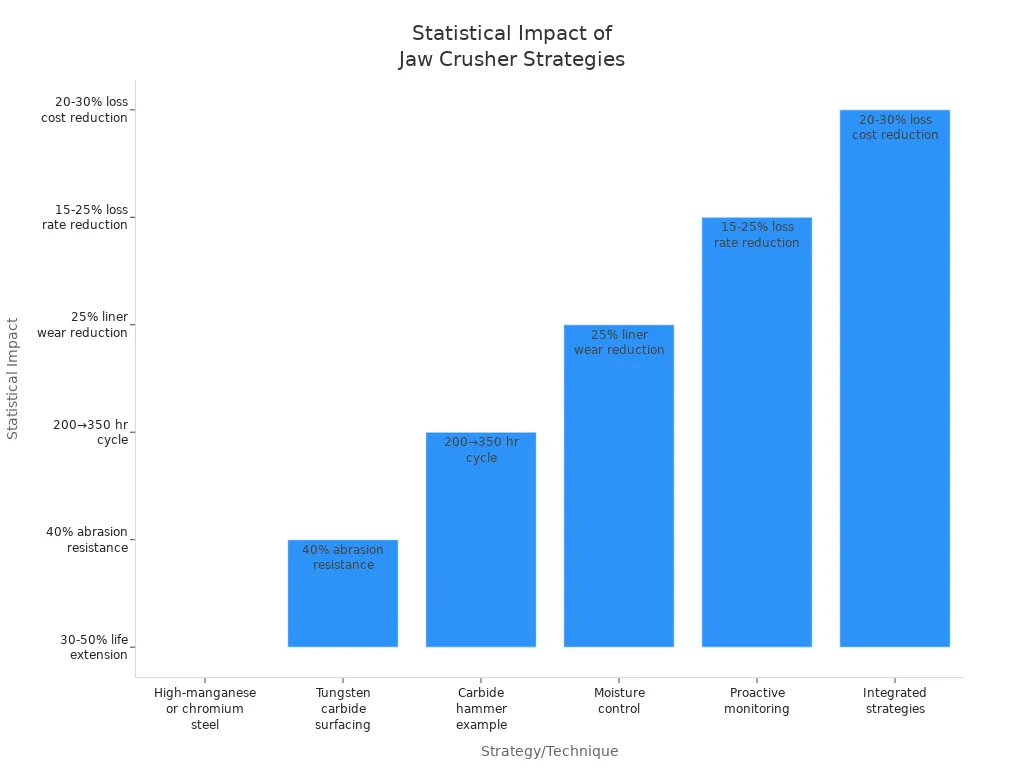
খাদ্য উপাদানের বৈশিষ্ট্যগুলি পরিষেবা জীবন নির্ধারণে গুরুত্বপূর্ণ ভূমিকা পালন করেচোয়াল পেষণকারী যন্ত্রাংশ। কঠোরতা, ঘর্ষণ, কণার আকার এবং আর্দ্রতা নিয়ন্ত্রণকারী অপারেটররা এর আয়ুষ্কাল বাড়াতে পারেনম্যাঙ্গানিজ ইস্পাত চোয়াল পেষণকারী পরিধান যন্ত্রাংশ.
- উচ্চ কঠোরতা এবং ঘর্ষণ ক্ষমতা প্রতিস্থাপনের হার এবং শক্তির ব্যবহার বৃদ্ধি করে।
- আর্দ্রতা এবং আঠালোতা প্লাগিংয়ের কারণ হতে পারে, যার ফলে আরও রক্ষণাবেক্ষণের প্রয়োজন হয়।
- সামঞ্জস্যপূর্ণ ফিডের আকার ডাউনটাইম প্রতিরোধ করতে সাহায্য করে এবং ক্রাশারের কর্মক্ষমতা উন্নত করে।
ডান নির্বাচন করাচোয়াল পেষণকারী মেশিনএবংক্রাশার যন্ত্রাংশখরচ কমায় এবং দক্ষতা বাড়ায়।
কী Takeaways
- ফিড উপকরণের কঠোরতা এবং ঘর্ষণ ক্ষমতা চোয়ালের পেষণকারী যন্ত্রাংশের ক্ষয়ক্ষতি অনেকাংশে বৃদ্ধি করে, তাই অপারেটরদের তাদের সেটিংস সামঞ্জস্য করা উচিত এবং আংশিক আয়ু বাড়ানোর জন্য শক্তিশালী উপকরণ নির্বাচন করা উচিত।
- খাদ্যের আকার নিয়ন্ত্রণ করা এবং বড় আকারের পাথর বা জরিমানা অপসারণ অসম ক্ষয় এবং বাধা প্রতিরোধ করতে সাহায্য করে, উন্নতি করেপেষণকারীর দক্ষতাএবং রক্ষণাবেক্ষণ হ্রাস।
- আর্দ্রতা এবং আঠালো পদার্থ ক্রাশার যন্ত্রাংশের উপর আটকে থাকা এবং অতিরিক্ত চাপ সৃষ্টি করে, তাই শুকানো এবং স্ক্রিনিংয়ের মাধ্যমে আর্দ্রতা ব্যবস্থাপনা ক্রাশারগুলিকে সুচারুভাবে চলতে সাহায্য করে।
- ডান নির্বাচন করাচোয়াল প্লেট উপকরণএবং ফিড বৈশিষ্ট্যের উপর ভিত্তি করে ডিজাইনগুলি পরিধানের আয়ু বহুগুণ বাড়িয়ে দিতে পারে এবং ডাউনটাইম কমাতে পারে।
- নিয়মিত পরিদর্শন, সঠিক রক্ষণাবেক্ষণ এবং অপারেটর প্রশিক্ষণ প্রাথমিকভাবে ক্ষয়ক্ষতি সনাক্ত করতে এবং ক্রাশারগুলিকে দীর্ঘ সময়ের জন্য দক্ষতার সাথে পরিচালনা করতে অপরিহার্য।
মূল ফিড উপাদানের বৈশিষ্ট্য এবং চোয়াল পেষণকারী মেশিনের পরিধান
খাদ্য উপাদানের কঠোরতা
চোয়াল পেষণকারীর ক্ষয়ক্ষতির উপর প্রভাব ফেলে এমন সবচেয়ে গুরুত্বপূর্ণ বৈশিষ্ট্যগুলির মধ্যে একটি হল কঠোরতা। গ্রানাইট বা বেসাল্টের মতো শক্ত শিলাগুলিকে চূর্ণ করার জন্য আরও বেশি বল প্রয়োজন। এই অতিরিক্ত বল চোয়ালের প্লেট এবং লাইনারের উপর চাপ বাড়ায়। যখন অপারেটররা চোয়াল পেষণকারী মেশিনে শক্ত পদার্থ সরবরাহ করে, তখন প্লেটগুলি আরও বেশি কাটা এবং চিপিং ক্ষয় অনুভব করে। গবেষণায় দেখা গেছে যে উচ্চতর সংকোচনশীল শক্তি এবং ফ্র্যাকচার শক্ততার শিলাগুলি দ্রুত ক্ষয়ক্ষতির হার সৃষ্টি করে। অপারেটররা প্রায়শই লক্ষ্য করেন যে ছোট, শক্ত কণা প্রক্রিয়াকরণের সময় চোয়ালের মুক্তির প্রান্তটি প্রথমে ক্ষয়প্রাপ্ত হয়। ফিডের কঠোরতার উপর ভিত্তি করে ক্রাশার সেটিংস সামঞ্জস্য করা ক্ষয়ক্ষতি কমাতে এবং আংশিক আয়ু বাড়াতে সাহায্য করতে পারে।
ঘর্ষণ এবং খনিজ গঠন
ঘর্ষণ এবং খনিজ গঠনও পরিধানের ধরণে গুরুত্বপূর্ণ ভূমিকা পালন করে। কোয়ার্টজাইট এবং গ্রানাইটের মতো খনিজগুলি অত্যন্ত ঘর্ষণকারী। এই খনিজগুলি চোয়ালের প্লেটের সাথে ঘর্ষণ করে, যার ফলে পৃষ্ঠের দ্রুত ক্ষয় হয়। যদি খাবারে উচ্চ শতাংশ ঘর্ষণকারী খনিজ থাকে, তাহলে স্ট্যান্ডার্ডম্যাঙ্গানিজ স্টিলের লাইনারদ্রুত জীর্ণ হতে পারে। সঠিক লাইনার উপাদান নির্বাচন করা, যেমন উচ্চ-ক্রোম আয়রন বা কম্পোজিট অ্যালয়, এই ধরণের জীর্ণতা প্রতিরোধ করতে সাহায্য করতে পারে। অপারেটরদের ফিডে দূষণের দিকেও নজর রাখা উচিত, কারণ ট্র্যাম্প আয়রন বা বড় আকারের পাথরের কারণে প্রান্ত চিপিং এবং ফাটল দেখা দিতে পারে।
পরামর্শ: ফিডের খনিজ গঠনের সাথে লাইনার উপাদান মেলালে পরিধানের আয়ু পাঁচ গুণ পর্যন্ত বাড়ানো যায় এবং রক্ষণাবেক্ষণ খরচ কমানো যায়।
কণার আকার এবং আকার বিতরণ
কণার আকার এবং এর বন্টন সরাসরি চোয়ালের প্লেটগুলি কত ঘন ঘন প্রতিস্থাপনের প্রয়োজন তা প্রভাবিত করে। যখন ফিডে অনেক বড় আকারের পাথর থাকে, তখন চোয়ালের প্লেটের কিছু অংশ বারবার আঘাত পায়। এর ফলে অসম ক্ষয় হয় এবং ঘন ঘন প্রতিস্থাপন করা হয়। ফিডে অতিরিক্ত জরিমানা বাধা সৃষ্টি করতে পারে, যা প্লেটের আয়ুষ্কালও কমিয়ে দেয়। একটি সু-নিয়ন্ত্রিত ফিড আকার বন্টন সমান ক্ষয় এবং স্থিতিশীল অপারেশনকে উৎসাহিত করে। ফিডের আকার পর্যবেক্ষণ এবং সমন্বয়কারী অপারেটররা অপারেশনাল খরচ কমাতে পারে এবং চোয়াল ক্রাশার মেশিনকে দক্ষতার সাথে চালু রাখতে পারে।
আর্দ্রতা এবং আঠালোতা
চোয়াল ক্রাশারের কর্মক্ষমতা বৃদ্ধিতে ফিড ম্যাটেরিয়ালের আর্দ্রতা গুরুত্বপূর্ণ ভূমিকা পালন করে। যখন ফিড ম্যাটেরিয়ালে উচ্চ আর্দ্রতা থাকে, বিশেষ করে যখন ফাইন বা কাদামাটির সাথে মিশ্রিত করা হয়, তখন এটি প্রায়শই পরিচালনার ক্ষেত্রে সমস্যার সৃষ্টি করে। আঠালো পদার্থগুলি ক্রাশারের ভিতরের পৃষ্ঠের সাথে লেগে থাকে। এই আঠালো পদার্থ বাধা সৃষ্টি করতে পারে, যাকে ক্লগিংও বলা হয়, যা ক্রাশিং প্রক্রিয়াকে ব্যাহত করে।
অপারেটররা প্রায়শই লক্ষ্য করেন যে মাটির মতো আর্দ্র সূক্ষ্ম পদার্থগুলি সহজে ভেঙে যায় না। পরিবর্তে, এই উপকরণগুলি ক্রাশিং চেম্বারের ভিতরে একটি ঘন পদার্থে সংকুচিত হয়। "প্যানকেকিং" নামে পরিচিত এই প্রক্রিয়াটি ক্রাশারের মোটরের উপর লোড বাড়ায়। যদি নিয়ন্ত্রণ না করা হয়, তবে প্যানকেকিং ক্রাশারকে সম্পূর্ণরূপে বন্ধ করে দিতে পারে। যদিও আর্দ্রতা সরাসরি চোয়াল প্লেট বা লাইনারের পরিধানের হার বাড়ায় না, ফলস্বরূপ আটকে যাওয়া এবং মোটর ওভারলোড দক্ষতা হ্রাস করতে পারে এবং সময়ের সাথে সাথে দ্রুত পরিধানের কারণ হতে পারে।
খাদ্য উপাদানের আর্দ্রতা এবং আঠালোতা নিয়ন্ত্রণে সাহায্য করার জন্য বেশ কিছু ব্যবহারিক পদক্ষেপ:
- ৫% এর নিচে আর্দ্রতা কমাতে খাবার আগে থেকে শুকিয়ে নিলে উপাদান আটকে যাওয়া রোধ করতে সাহায্য করে।
- ক্রাশারে খাবার দেওয়ার আগে জরিমানা পরীক্ষা করে নিলে আটকে যাওয়ার ঝুঁকি কমে।
- ফিড চুটে টেফলন-কোটেড পৃষ্ঠের মতো অ্যান্টি-স্টিক লাইনার স্থাপন করলে উপাদানের আনুগত্য কম হয়।
- উপাদান প্রবাহকে পুনঃনির্দেশিত করার জন্য ব্যাফেল ওয়াল ব্যবহার করা, বিশেষ করে কম্পনকারী ফিডারের সাহায্যে, জমাট বাঁধা আরও কমাতে পারে।
দ্রষ্টব্য: যেসব অপারেটর আর্দ্রতার মাত্রা পর্যবেক্ষণ করে এবং তাদের প্রক্রিয়াগুলি সামঞ্জস্য করে, তারা মসৃণ ক্রাশার পরিচালনা বজায় রাখতে পারে এবং পরিধানের যন্ত্রাংশের আয়ু বাড়াতে পারে।
ফিড উপাদানের আর্দ্রতা এবং আঠালোতা নিয়ন্ত্রণ কেবল ক্রাশারের নির্ভরযোগ্যতা উন্নত করে না বরং রক্ষণাবেক্ষণ খরচও কমায়। এই পদক্ষেপগুলি গ্রহণের মাধ্যমে, অপারেটররা নিশ্চিত করে যে চোয়াল ক্রাশার মেশিনগুলি দক্ষতার সাথে কাজ করে, এমনকি যখন চ্যালেঞ্জিং উপকরণ প্রক্রিয়াজাতকরণ করা হয় তখনও।
চোয়াল পেষণকারী মেশিনের যন্ত্রাংশের উপর ফিড বৈশিষ্ট্যের প্রভাব
চোয়ালের প্লেট এবং লাইনার পরিধানের উপর কঠোরতার প্রভাব
ফিড উপাদানের কঠোরতা সরাসরি চোয়ালের প্লেট এবং লাইনারের ক্ষয়ক্ষতির হারকে প্রভাবিত করে। গ্রানাইট বা কোয়ার্টজাইটের মতো শক্ত শিলা ভাঙতে আরও বেশি বল প্রয়োজন হয়। এই বর্ধিত বল চোয়ালের ক্রাশারের সংস্পর্শের পৃষ্ঠের উপর চাপ বাড়ায়। সময়ের সাথে সাথে, শক্ত পদার্থের বারবার আঘাতের ফলে ছেনি কাটার ক্ষয় হয়, যা চোয়ালের প্লেটে গভীর আঁচড়, খাঁজ এবং গর্তের মতো দেখা যায়। অপারেটররা প্রায়শই লক্ষ্য করেন যে ক্রাশিং জোনগুলি সবচেয়ে তীব্র ক্ষয়ক্ষতির সম্মুখীন হয়, বিশেষ করে যখন উচ্চ-কঠোরতা আকরিক প্রক্রিয়াজাতকরণ করা হয়।
চোয়ালের প্লেটগুলি বারবার চাপ এবং ধাক্কার চাপের সম্মুখীন হলে ক্লান্তি ক্ষয়ও দেখা দেয়। ফাটল তৈরি হয় এবং ছড়িয়ে পড়ে, অবশেষে ভঙ্গুর ফ্র্যাকচারের সৃষ্টি করে। খাওয়ানোর জায়গা, যেখানে পাথর প্রথমে ক্রাশারে প্রবেশ করে, এই ধরণের ক্ষতির জন্য বিশেষভাবে ঝুঁকিপূর্ণ।উচ্চ ম্যাঙ্গানিজ স্টিলের চোয়াল প্লেটএই ক্ষয়ের কিছুটা প্রতিরোধ করতে পারে কারণ এগুলো ব্যবহারের সময় কঠোর হয়, কিন্তু অত্যন্ত শক্ত খাবারের সংস্পর্শে এলেও এই উপকরণগুলির সীমাবদ্ধতা রয়েছে।
টিপস: আগত উপাদানের কঠোরতা নিয়মিত পর্যবেক্ষণ করলে অপারেটররা ক্রাশার সেটিংস সামঞ্জস্য করতে এবং সঠিক লাইনার উপকরণ নির্বাচন করতে সাহায্য করে, যা অপ্রত্যাশিত ডাউনটাইম কমিয়ে দেয়।
ঘষিয়া তুলিয়া ফেলিতে সক্ষম খনিজ পদার্থ এবং পৃষ্ঠের অবক্ষয়
ফিডে থাকা ঘষিয়া তুলিয়া ফেলিতে সক্ষম খনিজ পদার্থ, যেমন কোয়ার্টজ বা সিলিকা, পৃষ্ঠের অবক্ষয়কে ত্বরান্বিত করেচোয়াল পেষণকারী যন্ত্রাংশ। ল্যাবরেটরি ঘর্ষণ পরীক্ষা, যার মধ্যে রয়েছে গাউজিং ঘর্ষণ পরীক্ষা, বাস্তব জগতের ক্ষয়ক্ষতির ধরণগুলির সাথে একটি শক্তিশালী সম্পর্ক দেখায়। এই পরীক্ষাগুলি প্রকাশ করে যে ঘর্ষণকারী খনিজগুলি চোয়ালের প্লেট এবং লাইনারের পৃষ্ঠে মাইক্রোপ্লোয়িং, মাইক্রোকাটিং এবং মাইক্রোক্র্যাকিংয়ের কারণ হয়। ঘর্ষণকারী কণাগুলি ধাতুর উপর পিছলে এবং চাপ দিলে, তারা ছোট ছোট টুকরো অপসারণ করে, যার ফলে আয়তন হ্রাস পায় এবং পৃষ্ঠগুলি রুক্ষ হয়ে যায়।
মাঠ পর্যায়ের গবেষণা নিশ্চিত করে যে ঘষিয়া তুলিয়া ফেলিতে সক্ষম খনিজ পদার্থের উপস্থিতি পৃষ্ঠের ক্ষয়ের হার বৃদ্ধি করে। প্রধান পরিধান প্রক্রিয়াগুলির মধ্যে রয়েছে:
- কম চাপের স্ক্র্যাচিং ঘর্ষণ:যখন কণাগুলি খুব বেশি সংকোচন ছাড়াই পৃষ্ঠের উপর দিয়ে স্লাইড করে তখন ঘটে।
- উচ্চ-চাপযুক্ত গ্রাইন্ডিং ঘর্ষণ:চাপের মুখে যখন ছোট কণাগুলি পৃষ্ঠের সাথে পিষে যায় তখন এটি ঘটে।
- ঘর্ষণ:বড়, শক্ত কণা চোয়ালের প্লেটগুলিকে আঘাত করে এবং সংকুচিত করে।
নীচের সারণীতে সাধারণ পরিধানের ধরণ এবং তাদের কারণগুলির সংক্ষিপ্তসার দেওয়া হয়েছে:
| পোশাকের ধরণ | বিবরণ | কারণ / প্রভাব বিস্তারকারী কারণগুলি | চোয়াল প্লেট অঞ্চল | বল বৈশিষ্ট্য |
|---|---|---|---|---|
| চিসেল কাটিং ওয়্যার | গভীর আঁচড়, খাঁজ এবং গর্ত | আকরিক দ্বারা বারবার আঘাত এবং এক্সট্রুশন | ক্রাশিং জোন (M, ML, L) | উচ্চ স্বাভাবিক, মাঝারি স্পর্শক |
| ক্লান্তি পরিধান | ফাটল এবং ভঙ্গুর ফ্র্যাকচার | দীর্ঘমেয়াদী পুনরাবৃত্তিমূলক প্রভাব | খাওয়ানোর অঞ্চল (এইচ) | উচ্চ স্বাভাবিক, নিম্ন স্পর্শক |
| ঘষিয়া তুলিয়া ফেলিতে সক্ষম পোশাক | আঁচড়, পিষন, খোঁচা দিয়ে ঘর্ষণ | কণার আকার, কঠোরতা, সংকোচন/শিয়ার | ক্রাশিং জোন (M, ML, L) | উচ্চ স্বাভাবিক এবং স্পর্শক |
| জারা পরিধান | আর্দ্রতার কারণে জারণ | ফিডে আর্দ্রতার পরিমাণ | সকল অঞ্চল | রাসায়নিক পরিধান |
কঠোরতা, দৃঢ়তা এবং মাইক্রোস্ট্রাকচারের মতো উপাদানের বৈশিষ্ট্যগুলিও চোয়ালের পেষণকারী যন্ত্রাংশগুলি কতটা ঘষিয়া তুলিয়া ফেলিতে সক্ষম ক্ষয় প্রতিরোধ করে তা প্রভাবিত করে। পরিধানের ফলে লাইনারের জ্যামিতিতে পরিবর্তন ক্রাশারের কর্মক্ষমতাকে প্রভাবিত করতে পারে, যার ফলে নিয়মিত পরিদর্শন অপরিহার্য হয়ে ওঠে।
অতিরিক্ত ফিড এবং জরিমানা কন্টেন্টের প্রভাব
চোয়ালের প্লেট এবং লাইনারের ক্ষয়ক্ষতির ক্ষেত্রে খাদ্যের আকার বন্টন একটি গুরুত্বপূর্ণ ভূমিকা পালন করে। বড় আকারের পাথরগুলি চোয়ালের প্লেটে ঘনীভূত প্রভাব অঞ্চল তৈরি করে। এই আঘাতগুলি অসম ক্ষয়ক্ষতির কারণ হয়, কিছু অংশ অন্যদের তুলনায় দ্রুত ক্ষয়প্রাপ্ত হয়। যখন বড় কণাগুলি ক্রাশারে প্রবেশ করে, তখন তারা ক্ষয়ক্ষতির কারণও হতে পারে, যার ফলে গভীর খাঁজ এবং গর্ত তৈরি হয়।
ফিডে অতিরিক্ত জরিমানা একটি ভিন্ন চ্যালেঞ্জ উপস্থাপন করে। সূক্ষ্ম কণাগুলি বৃহৎ শিলাগুলির মধ্যে ফাঁক পূরণ করতে পারে, যা ব্লকেজের ঝুঁকি বাড়ায়। এই ব্লকেজগুলি ক্রাশারকে আরও বেশি কাজ করতে বাধ্য করে, তাপমাত্রা বৃদ্ধি করে এবং পরিধানযোগ্য অংশগুলির উপর চাপ সৃষ্টি করে। সময়ের সাথে সাথে, এটি ঘষিয়া তুলিয়া ফেলিতে সক্ষম এবং ক্লান্তিকর ক্ষয়কে ত্বরান্বিত করতে পারে, বিশেষ করে যদি জরিমানাগুলিতে ঘষিয়া তুলিয়া ফেলা খনিজ থাকে।
অপারেটররা এই ঝুঁকিগুলি পরিচালনা করতে পারেন:
- ক্রাশারে প্রবেশের আগে অতিরিক্ত জরিমানা অপসারণের জন্য খাদ্য উপাদান স্ক্রিনিং করা।
- উপাদানের আকার নিয়ন্ত্রণের জন্য বন্ধ পার্শ্ব সেটিং (CSS) সামঞ্জস্য করা।
- বড় আকারের পাথরের অনুপাত পর্যবেক্ষণ করা এবং খাদ্য ব্যবস্থা সামঞ্জস্য করা।
দ্রষ্টব্য: সামঞ্জস্যপূর্ণ ফিডের আকার এবং নিয়ন্ত্রিত সূক্ষ্মতার পরিমাণ চোয়ালের প্লেট জুড়ে সমান ক্ষয় বজায় রাখতে সাহায্য করে, চোয়াল ক্রাশার মেশিনের দক্ষতা এবং আয়ুষ্কাল উন্নত করে।
আর্দ্রতা-সম্পর্কিত পরিধান প্রক্রিয়া
ফিড উপাদানের আর্দ্রতা অপারেশনের সময় চোয়াল ক্রাশারের যন্ত্রাংশের ক্ষয়ক্ষতি পরিবর্তন করতে পারে। ক্রাশারের ভিতরের অবস্থার উপর নির্ভর করে জল লুব্রিকেন্ট এবং ক্ষয়ের জন্য অনুঘটক উভয়ই কাজ করে। শুষ্ক, মুক্ত-প্রবাহিত শিলার তুলনায় ভেজা বা আঠালো পদার্থ প্রক্রিয়াকরণের সময় অপারেটররা প্রায়শই বিভিন্ন ক্ষয়ের ধরণ দেখতে পান।
পরিধানের উপর আর্দ্রতার সরাসরি প্রভাব:
- জল পাথর এবং চোয়ালের প্লেটের মধ্যে একটি পাতলা স্তর তৈরি করতে পারে। এই স্তরটি কখনও কখনও ঘর্ষণ কমায়, যা ঘর্ষণকারী ক্ষয়কে ধীর করে দেয়।
- অনেক ক্ষেত্রে, আর্দ্রতা সূক্ষ্ম কণা এবং কাদামাটির সাথে মিশে যায়। এই মিশ্রণটি একটি আঠালো পেস্ট তৈরি করে যা চোয়ালের প্লেট এবং লাইনারগুলিতে লেগে থাকে।
- আঠালো উপাদান "প্যানকেকিং" সৃষ্টি করে, যেখানে ভেজা সূক্ষ্ম পদার্থের স্তরগুলি ক্রাশার পৃষ্ঠের উপর জমা হয়। এই স্তরগুলি ঘষিয়া তুলিয়া ফেলিতে সক্ষম কণাগুলিকে আটকে রাখে এবং ধাতুর বিরুদ্ধে গ্রাইন্ডিং ক্রিয়া বৃদ্ধি করে।
পরোক্ষ প্রভাব এবং গৌণ ক্ষতি:
- আর্দ্রতা ক্ষয়কে উৎসাহিত করে, বিশেষ করে যখন জলের সাথে বিক্রিয়া করে এমন খনিজ পদার্থের সাথে মিলিত হয়। ক্ষয় চোয়ালের প্লেট এবং লাইনারের পৃষ্ঠকে দুর্বল করে দেয়, যা তাদের যান্ত্রিক ক্ষয়ের জন্য আরও ঝুঁকিপূর্ণ করে তোলে।
- ভেজা খাবারের উপাদান প্রায়শই বাধা সৃষ্টি করে। যখন ক্রাশার আটকে যায়, তখন বাধা অপসারণের জন্য মেশিনটিকে আরও কঠোর পরিশ্রম করতে হয়। এই অতিরিক্ত বল পরিধানযোগ্য অংশগুলির উপর চাপ বাড়ায়।
- উচ্চ আর্দ্রতার কারণে অসম ক্ষয় হতে পারে। চোয়ালের প্লেটের কিছু অংশ ভেজা পদার্থ দ্বারা আবৃত থাকতে পারে, আবার কিছু অংশ উন্মুক্ত থাকে। এই পার্থক্যের ফলে বিভিন্ন ধরণের ক্ষয় দেখা দেয় এবং যন্ত্রাংশের সামগ্রিক আয়ুষ্কাল হ্রাস পায়।
বিঃদ্রঃ:অপারেটরদের ফিডে আর্দ্রতার পরিমাণ এবং জরিমার ধরণ উভয়ই পর্যবেক্ষণ করা উচিত। উচ্চ জলীয় উপাদান সহ কাদামাটি সমৃদ্ধ উপকরণ পরিষ্কার, ভেজা বালির চেয়ে বেশি ক্ষয়ক্ষতির কারণ হয়।
সাধারণ আর্দ্রতা-সম্পর্কিত পরিধান প্রক্রিয়া:
| প্রক্রিয়া | বিবরণ | সাধারণ ফলাফল |
|---|---|---|
| তৈলাক্তকরণ প্রভাব | জলের ফিল্ম ঘর্ষণ কমায় | ধীর ঘষিয়া তুলিয়া ফেলিতে সক্ষম পরিধান |
| প্যানকেকিং/বিল্ড-আপ | আঠালো জরিমানা পৃষ্ঠের সাথে লেগে থাকে | বর্ধিত গ্রাইন্ডিং এবং ক্ষয় |
| ক্ষয়কারী পোশাক | পানি এবং খনিজ পদার্থ রাসায়নিক বিক্রিয়ার কারণ হয় | মরিচা, গর্ত, পৃষ্ঠের ক্ষতি |
| বাধা-প্ররোচিত চাপ | ভেজা উপাদান ক্রাশারকে আটকে রাখে, লোড বাড়ায় | ত্বরিত ক্লান্তি এবং ক্ষয় |
| অসম পোশাকের ধরণ | আর্দ্রতা কিছু জায়গাকে ঢেকে রাখে, আবার কিছু জায়গা উন্মুক্ত করে দেয় | এলোমেলো, অপ্রত্যাশিত ক্ষত |
আর্দ্রতা-সম্পর্কিত পোশাক পরিচালনার ব্যবহারিক পদক্ষেপ:
- অপারেটররা চূর্ণ করার আগে অতিরিক্ত জরিমানা এবং কাদামাটি অপসারণের জন্য ফিড উপাদানগুলি প্রাক-স্ক্রিন করতে পারেন।
- আর্দ্রতা সেন্সর ইনস্টল করলে ফিডের অবস্থার পরিবর্তন ট্র্যাক করতে সাহায্য করে।
- চুট এবং ক্রাশার পৃষ্ঠে অ্যান্টি-স্টিক লাইনার বা আবরণ ব্যবহার করলে উপাদান জমা হওয়া কম হয়।
- নিয়মিত পরিষ্কার এবং পরিদর্শন ক্ষয় এবং বাধা থেকে দীর্ঘমেয়াদী ক্ষতি প্রতিরোধ করে।
টিপ:ফিডে আর্দ্রতা এবং জরিমানা নিয়ন্ত্রণকারী অপারেটররা চোয়াল ক্রাশার যন্ত্রাংশের আয়ু বাড়াতে পারে এবং অপরিকল্পিত ডাউনটাইম কমাতে পারে।
আর্দ্রতা-সম্পর্কিত পরিধান প্রক্রিয়া শিল্প ক্রাশিংয়ে অনন্য চ্যালেঞ্জ উপস্থাপন করে। এই প্রভাবগুলি বোঝার মাধ্যমে, অপারেটররা ফিড প্রস্তুতি, ক্রাশার সেটিংস এবং রক্ষণাবেক্ষণের সময়সূচী সম্পর্কে আরও ভাল সিদ্ধান্ত নিতে পারে। এই জ্ঞান দীর্ঘতর আংশিক জীবন এবং আরও নির্ভরযোগ্য ক্রাশার কর্মক্ষমতা অর্জনের দিকে পরিচালিত করে।
ইন্ডাস্ট্রিয়াল কেস স্টাডি: চোয়াল পেষণকারী মেশিনের কর্মক্ষমতা

উচ্চ-কঠোরতা আকরিক প্রক্রিয়াকরণ
খনির কাজকর্মে প্রায়শই গ্রানাইট বা কোয়ার্টজাইটের মতো অত্যন্ত উচ্চ কঠোরতা সম্পন্ন আকরিক প্রক্রিয়াজাত করা হয়। এই উপকরণগুলি চোয়ালের পেষণকারী যন্ত্রাংশের উপর চরম চাপ সৃষ্টি করে। অপারেটররা লক্ষ্য করেন যে এই শক্ত পাথরগুলিকে চূর্ণ করার সময় চোয়ালের প্লেট এবং লাইনারগুলি দ্রুত জীর্ণ হয়ে যায়। উচ্চ ম্যাঙ্গানিজ স্টিলের প্লেটগুলি এই ক্ষয় প্রতিরোধ করতে সাহায্য করে কারণ ব্যবহারের সময় এগুলি শক্ত হয়ে যায়। একটি খনির স্থানে, অপারেটররা একটি বিশেষ দাঁত প্রোফাইল সহ কাস্টম চোয়ালের প্লেটগুলিতে স্যুইচ করেছিলেন। এই পরিবর্তনের ফলে পরিধানের আয়ু উন্নত হয়েছে এবং রক্ষণাবেক্ষণের জন্য বন্ধের সংখ্যা হ্রাস পেয়েছে। নিয়মিত পরিদর্শন এবং জীর্ণ অংশগুলির সময়মত প্রতিস্থাপন ক্রাশারটিকে সুচারুভাবে চলতে সাহায্য করেছে। মেশিনে অতিরিক্ত লোড এড়াতে অপারেটররা ফিড ব্যবস্থাও সামঞ্জস্য করেছে।
ঘষিয়া তুলিয়া ফেলিতে সক্ষম সমষ্টি উৎপাদন
ঘষিয়া তুলিয়া ফেলিতে সক্ষম সমষ্টি উৎপাদন, যেমন বেসাল্ট বা কোয়ার্টজ সমৃদ্ধ নুড়ি চূর্ণ করা, চোয়ালের পেষণকারী যন্ত্রাংশের জন্য একটি কঠোর পরিবেশ তৈরি করে। অপারেটররা এই পরিবেশে উচ্চ ঘর্ষণ এবং প্রভাব বল দেখতে পান। তারা চোয়ালের প্লেটের জন্য ম্যাঙ্গানিজ স্টিলের মতো উচ্চমানের উপকরণ ব্যবহার করে কারণ এর কাজ-শক্তকরণ বৈশিষ্ট্য রয়েছে। প্লেটের আকৃতি এবং দাঁতের প্রোফাইল ক্ষয় নিয়ন্ত্রণে গুরুত্বপূর্ণ ভূমিকা পালন করে। নির্দিষ্ট সমষ্টির জন্য পরিধানের যন্ত্রাংশ কাস্টমাইজ করা ক্ষয়কে আরও সমানভাবে বিতরণ করতে সহায়তা করে এবং দক্ষতা বৃদ্ধি করে। এই পরিবেশে অপারেটররা কঠোর রক্ষণাবেক্ষণের সময়সূচী অনুসরণ করে। অপ্রত্যাশিত ব্যর্থতা রোধ করতে তারা সঠিক সময়ে যন্ত্রাংশ প্রতিস্থাপন করে।
- ঘষিয়া তুলিয়া ফেলিতে সক্ষম সামগ্রিক উৎপাদনে চোয়াল পেষণকারী পরিধানের যন্ত্রাংশগুলি উল্লেখযোগ্য ঘর্ষণ এবং প্রভাব বলগুলির সম্মুখীন হয়।
- উচ্চমানের উপকরণ এবং কাস্টম ডিজাইন ক্ষয় প্রতিরোধ করতে এবং দক্ষতা উন্নত করতে সাহায্য করে।
- পরিধানের সময়কাল সর্বোত্তম করার জন্য রক্ষণাবেক্ষণের সময় অত্যন্ত গুরুত্বপূর্ণ।
নীচের একটি সারণীতে ঘষিয়া তুলিয়া ফেলিতে সক্ষম এবং কম ঘষিয়া তুলিয়া ফেলিতে সক্ষম প্রয়োগের মধ্যে পার্থক্যগুলি সংক্ষিপ্ত করা হয়েছে:
| আবেদনের ধরণ | পরিধানের হার | ব্যবহৃত উপাদান | রক্ষণাবেক্ষণের প্রয়োজন |
|---|---|---|---|
| ঘষিয়া তুলিয়া ফেলিতে সক্ষম সমষ্টি | উচ্চ | ম্যাঙ্গানিজ স্টিল | ঘন ঘন, নির্ধারিত |
| কম ঘষিয়া তুলিয়া ফেলিতে সক্ষম | নিম্ন | স্ট্যান্ডার্ড অ্যালয় | কম ঘন ঘন |
পুনর্ব্যবহারযোগ্য অ্যাপ্লিকেশনগুলিতে পরিবর্তনশীল ফিডের আকার
পুনর্ব্যবহারের কাজগুলি প্রায়শই আকার এবং আকৃতিতে পরিবর্তিত ফিড উপাদানের সাথে সম্পর্কিত। এই পরিবর্তনশীলতা চোয়াল পেষণকারী মেশিনের কর্মক্ষমতা এবং অংশের স্থায়িত্বকে প্রভাবিত করে। অপারেটররা কখনও কখনও ফিডে বড় বা অদ্ভুত আকৃতির টুকরো থাকলে আটকে যাওয়া বা এমনকি মেশিন বন্ধ হয়ে যেতে দেখেন। ফিডের উচ্চতার সাথে ক্রাশার চোয়ালের স্থানচ্যুতি পরিবর্তিত হয়, যা দক্ষতার উপর প্রভাব ফেলে। পুনর্ব্যবহারের জন্য চোয়াল পেষণকারী বেছে নেওয়ার আগে, অপারেটররা উপাদানের বৈশিষ্ট্য এবং প্রত্যাশিত ফিডের আকার বিশ্লেষণ করে। শক্তির ব্যবহার উপাদানের শক্তি এবং ক্রাশারের অ্যাপারচার আকারের উপরও নির্ভর করে। উচ্চ-শক্তির কংক্রিট ক্রাশিং নরম উপকরণের তুলনায় অনেক বেশি শক্তি ব্যবহার করে। অ্যাপারচারের ছোট আকারও শক্তি খরচ বাড়ায়। এই কারণগুলি দেখায় যে পরিবর্তনশীল ফিডের আকার এবং উপাদানের বৈশিষ্ট্যগুলি ক্রাশারের কর্মক্ষমতা এবং পরিধানের অংশের জীবনে একটি বড় ভূমিকা পালন করে।
যেসব অপারেটর ফিডের আকার পর্যবেক্ষণ করে এবং ক্রাশার সেটিংস সামঞ্জস্য করে, তারা ক্ষয়ক্ষতি কমাতে এবং পুনর্ব্যবহারযোগ্য অ্যাপ্লিকেশনগুলিতে দক্ষতা উন্নত করতে পারে।
চোয়াল ক্রাশার মেশিন পরিচালনায় পর্যবেক্ষণ এবং ক্ষয় হ্রাস
চোয়ালের প্লেট এবং লাইনারের উপকরণ নির্বাচন করা
ডান নির্বাচন করাচোয়াল প্লেট এবং লাইনার উপকরণশিল্প ক্রাশারগুলিতে ক্ষয়ক্ষতি কমানোর জন্য এটি অপরিহার্য। অপারেটররা প্রায়শই ফিডের কঠোরতা এবং ঘর্ষণ ক্ষমতার উপর ভিত্তি করে ম্যাঙ্গানিজ স্টিলের গ্রেড নির্বাচন করেন। নীচের সারণীতে সাধারণ উপকরণ এবং তাদের কর্মক্ষমতার তুলনা করা হয়েছে:
| উপাদানের ধরণ | মূল বৈশিষ্ট্য | শক্ত/ঘষিয়া তুলিয়া ফেলিতে সক্ষম উপকরণের জন্য উপযুক্ততা | Mn18Cr2 এর তুলনায় পরিধানের জীবন |
|---|---|---|---|
| Mn14Cr2 সম্পর্কে | উচ্চ প্রভাব শক্তি, ঘর্ষণ প্রতিরোধ ক্ষমতা | নরম বা অ-ক্ষয়কারী পাথর | বেসলাইন |
| Mn18Cr2 সম্পর্কে | চমৎকার কাজ-কঠিনতা, ঘর্ষণ প্রতিরোধ ক্ষমতা | মাঝারি থেকে কঠিন, ঘষিয়া তুলিয়া ফেলিতে সক্ষম নয় এমন পাথর | বেসলাইন |
| Mn22Cr2 সম্পর্কে | উচ্চতর ঘর্ষণ প্রতিরোধ ক্ষমতা, দীর্ঘ পরিধান জীবন | শক্ত এবং ঘষিয়া তুলিয়া ফেলিতে সক্ষম পাথর | Mn18Cr2 এর চেয়ে দীর্ঘ |
| টিআইসি সন্নিবেশ | অত্যন্ত উচ্চ কঠোরতা, প্রভাব প্রতিরোধী | খুব শক্ত এবং ঘষিয়া তুলিয়া ফেলিতে সক্ষম উপকরণ | Mn18Cr2 এর চেয়ে 1.5 থেকে 2.5 গুণ বেশি |

যেসব অপারেটররা শক্ত বা ঘষিয়া তুলিয়া ফেলিতে সক্ষম ফিড উপকরণ প্রক্রিয়াজাত করেন তারা প্রায়শই দীর্ঘ পরিধানের জীবন এবং কম ডাউনটাইমের জন্য Mn22Cr2 বা TIC ইনসার্ট প্লেট বেছে নেন।
ক্রাশার সেটিংস এবং ফিড ব্যবস্থা সামঞ্জস্য করা
সঠিক ক্রাশার সেটিংস এবং ফিড ব্যবস্থা চোয়ালের প্লেট এবং লাইনারের আয়ু বাড়াতে সাহায্য করে। অপারেটররা বেশ কয়েকটি কৌশল ব্যবহার করে:
- ইন-লাইন ফিডিং উপাদানগুলিকে ক্রাশার খোলার সাথে সারিবদ্ধ করে, আটকে থাকা এবং অসম ক্ষয় হ্রাস করে।
- চক ফিডিং চেম্বারটিকে কমপক্ষে ৮০% পূর্ণ রাখে, যা একই রকম ক্ষয় এবং দক্ষ ক্রাশিং বৃদ্ধি করে।
- প্রাক-স্ক্রিনিং জরিমানা এবং অতিরিক্ত আকারের উপাদান অপসারণ করে, বাধা এবং অসম ক্ষয় রোধ করে।
- ভালোভাবে গ্রেড করা ফিড স্থিতিশীল থ্রুপুট নিশ্চিত করে এবং স্থানীয় ক্ষয়ক্ষতি কমায়।
- ফিডে ধাতব উপাদান সীমিত করলে উপাদানগুলিকে ক্ষতির হাত থেকে রক্ষা পাওয়া যায়।
ক্লোজড-সাইড সেটিং সামঞ্জস্য করলে নিপ অ্যাঙ্গেল এবং ক্রাশিং দক্ষতাও নিয়ন্ত্রণ করা হয়। ধারাবাহিক চোক ফিডিং এবং সঠিক সেটিংস সমান পরিধানের হার বজায় রাখে এবং চোয়াল ক্রাশার মেশিনের স্থায়িত্ব উন্নত করে।
রক্ষণাবেক্ষণ কৌশল এবং পরিধান পর্যবেক্ষণ
কার্যকর রক্ষণাবেক্ষণ কৌশলগুলি ক্ষয়ক্ষতি হ্রাস করে এবং অপ্রত্যাশিত ব্যর্থতা প্রতিরোধ করে। অপারেটররা নির্ভর করে:
- প্রতিরোধমূলক রক্ষণাবেক্ষণ, যার মধ্যে রয়েছে নির্ধারিত পরিদর্শন এবং ব্যর্থতা হওয়ার আগে যন্ত্রাংশ প্রতিস্থাপন।
- অস্বাভাবিক পরিস্থিতি প্রাথমিকভাবে সনাক্ত করতে এবং সময়মত মেরামতের পরিকল্পনা করতে সেন্সর এবং পর্যবেক্ষণ সরঞ্জাম ব্যবহার করে ভবিষ্যদ্বাণীমূলক রক্ষণাবেক্ষণ।
- উন্নত পর্যবেক্ষণ ব্যবস্থা, যেমন অতিস্বনক সেন্সর এবং টেলিমেটিক্স, ফিডের স্তর এবং সরঞ্জামের অবস্থার উপর রিয়েল-টাইম ডেটা সরবরাহ করে।
অপারেটররা এই কৌশলগুলি ব্যবহার করে ক্ষয়ক্ষতির অগ্রগতি ট্র্যাক করে এবং প্রয়োজন অনুসারে ক্রিয়াকলাপ সামঞ্জস্য করে। রিয়েল-টাইম পর্যবেক্ষণ এবং অটোমেশন স্থিতিশীল উপাদান প্রবাহ বজায় রাখতে, ক্ষয়ক্ষতি কমাতে এবং ক্রাশার কর্মক্ষমতা উন্নত করতে সহায়তা করে।
পরামর্শ: আধুনিক পর্যবেক্ষণ প্রযুক্তির সাথে প্রতিরোধমূলক এবং ভবিষ্যদ্বাণীমূলক রক্ষণাবেক্ষণের সমন্বয়ের ফলে আংশিক জীবনকাল দীর্ঘ হয় এবং অপরিকল্পিত শাটডাউন কম হয়।
বর্ধিত আংশিক জীবনের জন্য ভবিষ্যদ্বাণীমূলক পদ্ধতি
আধুনিক শিল্প কার্যক্রমগুলি চোয়াল ক্রাশার মেশিনগুলিকে দক্ষতার সাথে চালানোর জন্য ভবিষ্যদ্বাণীমূলক রক্ষণাবেক্ষণের উপর নির্ভর করে। ভবিষ্যদ্বাণীমূলক পদ্ধতিগুলি প্রযুক্তি এবং নিয়মিত পর্যবেক্ষণ ব্যবহার করে সমস্যাগুলি ক্ষতির আগে সনাক্ত করে। অপারেটররা এই স্মার্ট পদ্ধতিগুলি অনুসরণ করে চোয়াল ক্রাশার যন্ত্রাংশের আয়ু বাড়াতে পারেন:
- লুব্রিকেটিং তেলের তাপমাত্রা এবং ফিল্টারের অবস্থা পর্যবেক্ষণ করার জন্য সেন্সর ইনস্টল করুন। পরিবর্তনগুলির প্রাথমিক সনাক্তকরণ সম্ভাব্য সমস্যার ইঙ্গিত দেয়।
- বিস্তারিত চেকলিস্ট ব্যবহার করে দৈনিক, সাপ্তাহিক এবং মাসিক পরিদর্শনের সময়সূচী নির্ধারণ করুন। নিয়মিত পরীক্ষা গুরুতর হওয়ার আগেই ক্ষয়ক্ষতি ধরাতে সাহায্য করে।
- ZGMn13 এর মতো উচ্চ ম্যাঙ্গানিজযুক্ত চোয়ালের প্লেটগুলি বেছে নিন। এই উপকরণগুলি কঠিন পরিস্থিতিতে দীর্ঘস্থায়ী হয়।
- বোল্ট এবং নাট শক্ত করুন, এবং দাঁতের শিখরগুলিকে উপত্যকার সাথে মিলিয়ে দিন। সঠিক সমাবেশ অসম ক্ষয় এবং প্রাথমিক অংশের ব্যর্থতা রোধ করে।
- কম্পন হ্রাসকারী ডিভাইস যোগ করুন এবং ফিড রেট নিয়ন্ত্রণ করুন। এই পদক্ষেপগুলি ক্রাশারের উপর চাপ কমায় এবং ক্ষয়ক্ষতির গতি কমায়।
ভবিষ্যদ্বাণীমূলক রক্ষণাবেক্ষণ ব্যবহারকারী অপারেটররা কম অপ্রত্যাশিত ব্রেকডাউন এবং দীর্ঘ আংশিক জীবন দেখতে পান।
বাস্তব-বিশ্বের তথ্য এই কৌশলগুলির প্রভাব দেখায়। নীচের সারণীতে ভবিষ্যদ্বাণীমূলক রক্ষণাবেক্ষণের মূল উন্নতিগুলি তুলে ধরা হয়েছে:
| পারফরম্যান্স মেট্রিক | উন্নতি পরিসংখ্যান | প্রভাবের বর্ণনা |
|---|---|---|
| ক্রাশার যন্ত্রাংশের জীবনকাল বৃদ্ধি | ৩০% পর্যন্ত | উচ্চমানের উপকরণ এবং ভবিষ্যদ্বাণীমূলক যত্ন প্রতিস্থাপন কমায়। |
| ডাউনটাইম হ্রাস | ৩০% পর্যন্ত | স্মার্ট সেন্সর এবং প্রাথমিক সনাক্তকরণ অপরিকল্পিত স্টপগুলি কেটে দেয়। |
| রক্ষণাবেক্ষণ খরচ সাশ্রয় | ৩০% পর্যন্ত | চাহিদা-ভিত্তিক রক্ষণাবেক্ষণ খরচ কমায়। |
| ওয়্যার পার্টের লাইফেন্স এক্সটেনশন (এআই-চালিত) | ১৫-২০% | এআই এবং অটোমেশন স্থায়িত্ব বাড়ায়। |
| লাইনার প্রতিস্থাপন ফ্রিকোয়েন্সি হ্রাস | ৩৫% | ভবিষ্যদ্বাণীমূলক সরঞ্জামের অর্থ হল লাইনার পরিবর্তন কম। |
| পরিধানের অংশের জীবনকাল বৃদ্ধি (অটোমেশন) | ২ থেকে ৪ বার | স্বয়ংক্রিয় অপ্টিমাইজেশন আংশিক জীবনকে ব্যাপকভাবে প্রসারিত করে। |

স্মার্ট ক্রাশার কন্ট্রোল সিস্টেম, যেমন লিডিং অপারেশনে ব্যবহৃত হয়, ওয়্যার পার্টসের আয়ুষ্কাল ১৫-২০% বৃদ্ধি করেছে। ডাউনটাইম ইভেন্ট ৪০% কমেছে এবং লাইনার প্রতিস্থাপনের ফ্রিকোয়েন্সি ৩৫% কমেছে। তাপমাত্রা, কম্পন এবং ওয়্যার ট্র্যাক করে এমন সেন্সরগুলি ব্যর্থতা হওয়ার আগে অপারেটরদের কাজ করতে সাহায্য করে। প্রতিক্রিয়াশীল থেকে ভবিষ্যদ্বাণীমূলক রক্ষণাবেক্ষণের এই পরিবর্তন মেশিনগুলিকে দীর্ঘ সময় ধরে চলতে সাহায্য করে এবং অর্থ সাশ্রয় করে। ভবিষ্যদ্বাণীমূলক পদ্ধতিগুলি অপারেটরদের তাদের চোয়াল ক্রাশারের কর্মক্ষমতার উপর আরও নিয়ন্ত্রণ এবং আত্মবিশ্বাস দেয়।
চোয়াল পেষণকারী মেশিনের পার্ট লাইফ অপ্টিমাইজ করার জন্য সেরা অনুশীলনগুলি
চোয়ালের প্লেটের উপাদানের সাথে খাবারের বৈশিষ্ট্যের মিল
ক্রাশার পার্টস লাইফ সর্বাধিক করার জন্য সঠিক চোয়াল প্লেট উপাদান এবং নকশা নির্বাচন করা অপরিহার্য। অপারেটরদের উচিত:
- উপাদানের ঘর্ষণ ক্ষমতার উপর ভিত্তি করে চোয়াল প্লেট অ্যালয় বেছে নিন। চুনাপাথরের মতো কম ঘর্ষণ ক্ষমতা সম্পন্ন উপকরণের জন্য M1 অ্যালয় ভালো কাজ করে। গ্রানাইট বা লৌহ আকরিকের মতো উচ্চ ঘর্ষণ ক্ষমতা সম্পন্ন উপকরণের জন্য M2, M7, M8, অথবা M9 এর মতো প্রিমিয়াম অ্যালয় ভালো।
- ফিডের সাথে দাঁতের ধরণ মেলান। ওয়াইড টিথ (WT) ফিডের প্যাকিং প্রতিরোধ করে উচ্চ সূক্ষ্মতা সহ্য করতে সাহায্য করে। শার্প টিথ (ST) ফ্ল্যাকি বা কৌণিক ফিড ধরে রাখে, পিছলে যাওয়া কমায়। মোটা ঢেউতোলা (CC), হেভি ডিউটি (HD), অথবা আল্ট্রা-থিক (UT) প্লেটগুলি ঘষিয়া তুলিয়া ফেলিতে সক্ষম ফিড সহ্য করে।
- ক্রাশার মডেলের সুপারিশ অনুসরণ করুন। উদাহরণস্বরূপ, CJ615 ক্রাশারগুলি প্রায়শই ঘষিয়া তুলিয়া ফেলিতে সক্ষম ফিডের জন্য M8 অ্যালয় সহ মোটা ঢেউতোলা বা ভারী দায়িত্ব প্লেট ব্যবহার করে।
- চোয়ালের প্লেটগুলিকে তাদের জীবনচক্রের সময় ঘোরান যাতে সমানভাবে ক্ষয় হয় এবং সর্বোত্তম নিপ অ্যাঙ্গেল বজায় থাকে।
- ফিডের বৈশিষ্ট্যের সাথে মিল রেখে ক্রাশার সেটিংস, যেমন ক্লোজড সাইড সেটিং এবং নিপ অ্যাঙ্গেল সামঞ্জস্য করুন।
চোয়ালের প্লেটের উপাদান এবং নকশার সাথে খাবারের বৈশিষ্ট্যের মিল থাকলে কর্মক্ষমতা সর্বোত্তম হয় এবং আংশিক আয়ু বৃদ্ধি পায়।
নিয়মিত পরিদর্শন এবং সময়মত প্রতিস্থাপন
নিয়মিত পরিদর্শন এবং জীর্ণ যন্ত্রাংশ দ্রুত প্রতিস্থাপনের ফলে ক্রাশারগুলি দক্ষতার সাথে কাজ করে। অপারেটররা এর সুবিধা পান:
- চোয়ালের প্লেট, বিয়ারিং এবং অন্যান্য উপাদান নিয়মিত পরীক্ষা করে ক্ষয়ক্ষতি এবং ক্ষয়ক্ষতির প্রাথমিক সনাক্তকরণ।
- জীর্ণ অংশগুলি সময়মতো প্রতিস্থাপন করা, যা আরও ক্ষতি রোধ করে এবং ক্রাশিং দক্ষতা বজায় রাখে।
- চলমান যন্ত্রাংশের সঠিক তৈলাক্তকরণ, ঘর্ষণ হ্রাস এবং মেশিনের আয়ু বৃদ্ধি।
- মনিটরিং সিস্টেম যা অপারেটরদের সমস্যা সম্পর্কে সতর্ক করে, তাড়াতাড়ি রক্ষণাবেক্ষণে সহায়তা করে এবং মেরামতের খরচ কমায়।
পরিদর্শন এবং সময়মত যন্ত্রাংশ প্রতিস্থাপন সহ একটি সামঞ্জস্যপূর্ণ রক্ষণাবেক্ষণ সময়সূচী, সরঞ্জামের আপটাইম বৃদ্ধি করে এবং পরিচালন ব্যয় হ্রাস করে।
অপারেটর প্রশিক্ষণ এবং প্রক্রিয়া অপ্টিমাইজেশন
সুপ্রশিক্ষিত অপারেটর এবং অপ্টিমাইজড প্রক্রিয়াগুলি ক্ষয়ক্ষতি কমাতে গুরুত্বপূর্ণ ভূমিকা পালন করে। অপারেটরদের উচিত:
- ক্ষমতা বৃদ্ধি এবং ক্ষয় কমাতে সঠিক ফিড গ্রেডেশন ব্যবহার করুন এবং ফিডের হার নিয়ন্ত্রণ করুন।
- ক্ষয়ক্ষতির ক্ষতিপূরণ দিতে শিমস এবং টগল দৈর্ঘ্য ব্যবহার করে ক্রাশার সেটিংস, যেমন বন্ধ সাইড সেটিং সামঞ্জস্য করুন।
- সঠিক সেটিংস নিশ্চিত করতে চোয়ালের মধ্যে ফাঁক পরিমাপ করুন।
- অকাল ক্ষয় এড়াতে, ক্রাশারটি খালি থাকলে এবং বন্ধ থাকলেই কেবল সামঞ্জস্য করুন।
- ধারাবাহিক বিয়ারিং লুব্রিকেশনের জন্য স্বয়ংক্রিয় লুব্রিকেশন সিস্টেমের উপর নির্ভর করুন।
- ক্ষয় কমাতে এবং মেশিনের আয়ু বাড়ানোর জন্য খাওয়ানোর কৌশল এবং রক্ষণাবেক্ষণ পদ্ধতিগুলি বুঝুন।
অপারেটর প্রশিক্ষণ এবং প্রক্রিয়া অপ্টিমাইজেশন নির্ভরযোগ্য কর্মক্ষমতা নিশ্চিত করে এবং ক্রাশার যন্ত্রাংশের আয়ুষ্কাল সর্বাধিক করে তোলে।
ফিড উপাদানের বৈশিষ্ট্যগুলি পরিধানের হার এবং পরিষেবা জীবনকে চালিত করেক্রাশার যন্ত্রাংশশিল্পক্ষেত্রে। যেসব অপারেটররা সক্রিয় পর্যবেক্ষণ ব্যবহার করে, পরিধান-প্রতিরোধী উপকরণ নির্বাচন করে এবং অপারেশন সামঞ্জস্য করে, তারা আংশিক জীবনকাল ৫০% পর্যন্ত বাড়িয়ে দিতে পারে এবং রক্ষণাবেক্ষণ খরচ কমাতে পারে। শিল্প মানদণ্ড দেখায় যে সর্বোত্তম অনুশীলনগুলি অপারেশনাল খরচ ১০%-২০% কমিয়ে দেয় এবং সরঞ্জামের আয়ুষ্কাল ১৫% বৃদ্ধি করে। এই উন্নতিগুলি উচ্চ উৎপাদনশীলতা এবং বিনিয়োগের উপর শক্তিশালী রিটার্নের দিকে পরিচালিত করে।

প্রায়শই জিজ্ঞাসিত প্রশ্নাবলী
কোন খাদ্য উপাদানের বৈশিষ্ট্যের কারণে চোয়ালের প্লেট দ্রুত ক্ষয় হয়?
কঠোরতা এবং ঘর্ষণ ক্ষমতা দ্রুততম ক্ষয়ক্ষতির কারণ হয়। গ্রানাইট বা কোয়ার্টজযুক্ত খনিজ পদার্থের মতো শক্ত শিলা চোয়ালের প্লেটের সাথে পিষে যায়। অপারেটররা এই উপকরণগুলি প্রক্রিয়াকরণের সময় আরও ঘন ঘন প্রতিস্থাপন দেখতে পান।
খাদ্য উপাদানের আর্দ্রতা চোয়াল পেষণকারী যন্ত্রাংশগুলিকে কীভাবে প্রভাবিত করে?
আর্দ্রতার ফলে যন্ত্রাংশ আটকে যেতে পারে এবং অসম ক্ষয় হতে পারে। আঠালো উপকরণ, বিশেষ করে কাদামাটিযুক্ত, ক্রাশারের ভিতরে জমা হয়। এই জমাট বাঁধার ফলে যন্ত্রাংশের উপর চাপ বৃদ্ধি পায় এবং দ্রুত ক্ষয় হতে পারে।
অপারেটররা কি ফিডের আকার সামঞ্জস্য করে ক্ষয়ক্ষতি কমাতে পারে?
হ্যাঁ। যেসব অপারেটর ফিডের আকার নিয়ন্ত্রণ করে এবং বড় আকারের পাথর বা জরিমানা অপসারণ করে তারা সমানভাবে ক্ষয় বিতরণে সহায়তা করে। এই অনুশীলন চোয়াল প্লেটের আয়ু বাড়ায় এবং ক্রাশারের দক্ষতা উন্নত করে।
ঘষিয়া তুলিয়া ফেলিতে সক্ষম খাদ্যের জন্য কোন চোয়ালের প্লেট উপাদান সবচেয়ে ভালো কাজ করে?
ম্যাঙ্গানিজ ইস্পাতউচ্চ ক্রোমিয়াম বা টিআইসি সন্নিবেশ সহ ঘষিয়া তুলিয়া ফেলিতে সক্ষম ক্ষয় সবচেয়ে ভাল প্রতিরোধ করে। এই উপকরণগুলি শক্ত এবং ঘষিয়া তুলিয়া ফেলিতে সক্ষম পাথরগুলিকে পরিচালনা করে, দীর্ঘ পরিষেবা জীবন প্রদান করে।
অপারেটরদের কত ঘন ঘন চোয়াল ক্রাশার পরিধানের যন্ত্রাংশ পরিদর্শন করা উচিত?
অপারেটরদের উচিতপরিধানের যন্ত্রাংশ পরীক্ষা করাসাপ্তাহিক। নিয়মিত পরীক্ষা ক্ষতির প্রাথমিক লক্ষণগুলি সনাক্ত করতে সহায়তা করে। সময়মতো প্রতিস্থাপন অপ্রত্যাশিত ভাঙ্গন রোধ করে এবং ক্রাশারটি সুচারুভাবে চলমান রাখে।
পোস্টের সময়: জুলাই-১৭-২০২৫
